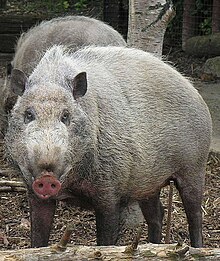| Sus Temporal range:
| |
|---|---|

| |
| Bornean bearded pig (Sus barbatus) | |
| Scientific classification | |
| Domain: | Eukaryota |
| Kingdom: | Animalia |
| Phylum: | Chordata |
| Class: | Mammalia |
| Order: | Artiodactyla |
| Family: | Suidae |
| Subfamily: | Suinae |
| Genus: | Sus Linnaeus, 1758 |
| Type species | |
| Sus scrofa[1] Linnaeus, 1758
| |
| Species | |
|
See text | |
Sus (/ˈsuːs/) is the genus of domestic and wild pigs, within the even-toed ungulate family Suidae. Sus include domestic pigs (Sus domesticus) and their ancestor, the common Eurasian wild boar (Sus scrofa), along with other species. Sus species, like all suids, are native to the Eurasian and African continents, ranging from Europe to the Pacific islands. Suids other than the pig are the babirusa of Indonesia, the pygmy hog of South Asia, the warthogs of Africa, and other pig genera from Africa. The suids are a sister Family (biology) to peccaries.
Juvenile pigs are known as piglets.[2] Pigs live in complex social groups and are considered one of the more intelligent mammals, as reflected in their ability to learn.[3]
With around 1 billion of this species alive at any time, the domestic pig is among the most populous large mammals in the world.[4][5] Pigs are omnivores and can consume a wide range of food.[6] Pigs are biologically similar to humans and are thus frequently used for human medical research.[7]
- ^ International Commission on Zoological Nomenclature (1922). "Opinion 75. Twenty-Seven Generic Names of Protozoa, Vermes, Pisces, Reptilia and Mammalia Included in the Official List of Zoological Names". Smithsonian Miscellaneous Collections. 73 (1): 35–37.
- ^ "Piglet". Merriam-Webster. 31 August 2012. Retrieved 15 September 2013.
- ^ Angier, Natalie (9 November 2009). "Pigs Prove to Be Smart, if Not Vain". The New York Times. ISSN 0362-4331.
- ^ "PSD Online". United States Department of Agriculture. Archived from the original on 2010-10-18. Retrieved 2008-08-17.
- ^ "Swine Summary Selected Countries". United States Department of Agriculture Foreign Agricultural Service. 14 October 2011. Archived from the original on 29 March 2012 – via Wayback Machine.
- ^ Kantharidis, Billy (27 June 2014). "Pig And Human Digestive System". Prezi. Retrieved 15 April 2016.
- ^ Grush, Loren (9 May 2014). "Why pigs are so valuable for medical research". Fox News. Retrieved 15 April 2016.